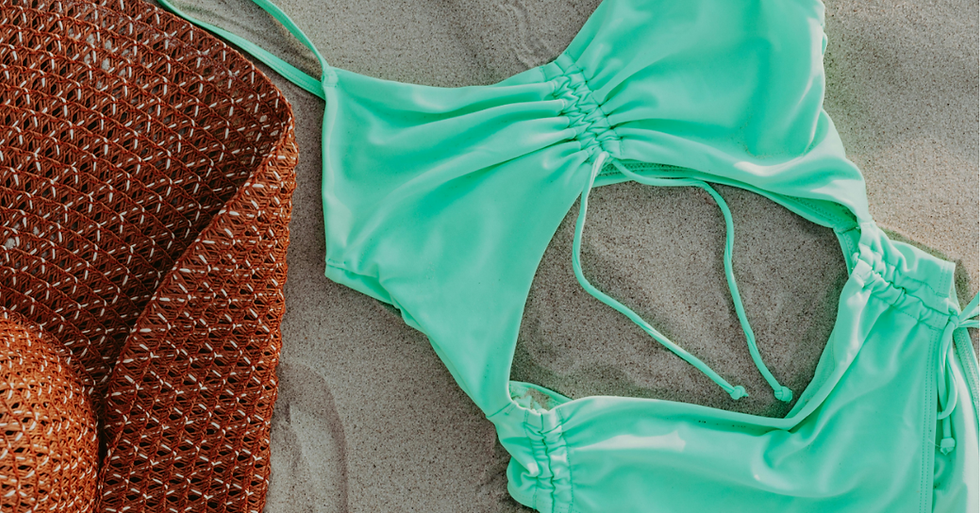The Evolution of Swimwear: From Modesty to Modern Style
- Kendyl Leuck
- Jun 30
- 3 min read

Swimwear has come a long way from woolen bathing dresses to string bikinis and sculptural one-pieces. What we wear to the beach or pool isn’t just about function—it’s a cultural mirror reflecting shifting ideas around gender, modesty, freedom, and body image. Let’s take a look at how swimwear has evolved across the decades—and how we ended up where we are now, in an era that celebrates both comfort and personal expression.
The 1800s: Bathing, Not Swimming
In the 19th century, swimming wasn’t the goal—bathing was. Women wore full-length dresses made of wool or flannel, often weighted at the hems to prevent the fabric from rising in the water (yes, really). These “bathing costumes” were designed to preserve modesty above all else, and mobility was... not exactly top of mind.
Men, on the other hand, often wore woolen one-pieces that looked like union suits—still conservative, but more functional than what women were dealing with.
Early 1900s: The Dawn of Sporty Swimwear
As swimming became more popular as a sport and pastime, swimwear started to reflect the need for movement. The early 20th century introduced slightly more practical silhouettes. In 1907, Australian swimmer Annette Kellerman was arrested in the U.S. for wearing a form-fitting one-piece—considered scandalous at the time—but she helped pave the way for more streamlined suits.
By the 1920s, swimsuits began exposing arms and legs, and fabrics became lighter. Still, most swimwear was made from wool, which soaked up water and sagged (imagine trying to dive in that).
The 1940s: Enter the Bikini
The biggest turning point? 1946. French engineer Louis Réard introduced the bikini—named after the Bikini Atoll, site of atomic bomb testing—because he believed it would make just as much of a splash. It was daring: a two-piece that exposed the navel, which was considered risqué. At first, it was banned in several countries, but actresses like Brigitte Bardot helped normalize the look on beaches and in film.
The 1960s–70s: Freedom & Fabric Innovation
The '60s and '70s saw an explosion of styles. Lycra and spandex revolutionized the fit and feel of swimwear, allowing for tighter, more flexible designs. This era was all about freedom of movement and expression—reflected in psychedelic prints, bandeaus, halters, and high-cut legs.
Swimwear also started to become more integrated into fashion. Think: cut-outs, bold patterns, and glam poolside aesthetics à la Slim Aarons photographs.
The 1980s–90s: Supermodels, Super High-Cuts
Cue the era of supermodels and Baywatch. One-pieces with ultra-high leg cuts and plunging necklines dominated the beach, and the "athletic bombshell" aesthetic was in full force. The bikini remained a mainstay, but silhouettes were shaped by the era’s love of excess—think metallics, neon, and dramatic embellishments.
2000s–Today: Diversity, Body Positivity & Function
In the last two decades, swimwear has become less about a one-size-fits-all aesthetic and more about celebrating individuality. Brands now offer extended sizing, mastectomy swimwear, modest options like swim hijabs, and sustainable materials that reduce environmental impact.
Influencers, not just fashion magazines, are shaping trends—bringing back retro silhouettes, experimenting with textures (like ribbed or terry cloth), and blurring the line between swimwear and ready-to-wear.
Today’s swimwear landscape is one of the most inclusive and creative yet. Whether you’re wearing a belted one-piece, a sporty two-piece, or a vintage-inspired ruched number, swimwear is now about feeling good in your skin—not covering it, shrinking it, or dressing it for anyone else’s expectations.
Swimwear, Then and Now
The journey from full-coverage wool dresses to cheeky cut-outs is more than just a fashion story—it’s a story of shifting values, expanding freedoms, and the ongoing conversation around body image and identity. As we head into another summer season, let’s remember: the best swimsuit is the one you feel most like yourself in.
Xx, Kendyl



